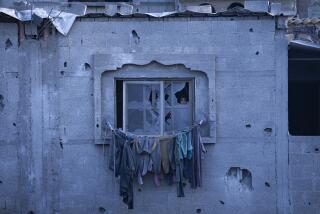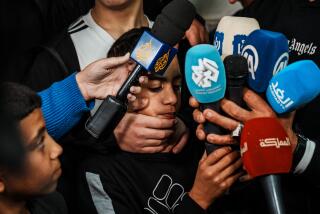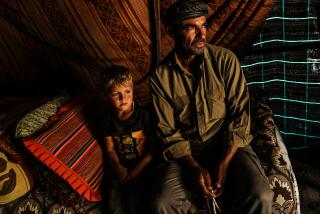COLUMN ONE : Trapped in a Vale of Tears : Death haunts the streets and soul of Kashmir. A fight to secede from India has brought a brutal crackdown and four years of fear and misery.
- Share via
SRINAGAR, India — Abdul Rashid, a bearded 40-year-old carpenter, and his wife, Haja, were enjoying a quiet lunch at home with their family when they sent their youngest son, Hilal, out to buy some yogurt.
Moments later, they heard running. Then screams. And then gunshots.
An Indian paramilitary officer had chased the 8-year-old boy down a winding cobblestone alley, into his home and up the narrow wooden stairs. Then he shot him twice. When the parents rushed down in horror, he shot and killed them too.
“My brother was still alive at first, crying for water,” sobbed Abida Rashid, 18, the boy’s older sister. “I said I must take him to the hospital. The soldiers said nothing. Then they just shot my parents on the spot. I began to scream. They said, ‘Go up, get away, don’t scream, or we’ll kill you too.’ ”
Two days after the Aug. 1 slayings, other Indian troops chased several dozen civilian protesters into the Dastgir Sahib, one of the city’s most important Muslim shrines. Then, as the crowd chanted anti-Indian slogans, the soldiers opened fire from the street.
Killed as they stood in an open window were Aijiz Ahmed, 13, and Nur Mohammed, 25, a father of two. Five others were wounded. Blood still stained the marble floor under the bullet-scarred window frame a day later.
“There was no provocation,” Riyaz Geelani, a shrine worker, said angrily. “We were chanting for freedom and justice. And they shot us.”
So goes one of the world’s dirtiest wars in one of its most spectacular settings. Long famous for its luxurious Victorian houseboats under majestic Himalayan peaks, its handwoven carpets and ancient Mogul gardens, the lush Vale of Kashmir has turned into a vale of suffering and death for many of its 4 million residents.
While largely ignored by the rest of the world, an estimated 300,000 Indian army and paramilitary forces have used summary executions, torture, arson and rape against both civilians and armed insurgents in the four years since a Muslim-led rebellion erupted in India’s northernmost state.
Indian security forces have intensified the repression in recent months in hopes of crushing the revolt by an estimated 7,000 to 10,000 Muslim guerrillas, who are fighting for independence from predominantly Hindu India or accession by neighboring Pakistan, India’s longtime Islamic enemy. Many of the militants have received training and arms in Pakistan.
As a result, more than human rights is at stake. Two of India’s three wars with Pakistan since 1947 were fought over Kashmir, and both countries now can assemble and deliver nuclear weapons on short notice, CIA Director R. James Woolsey told a congressional committee last month. He said the regional arms race poses “perhaps the most probable prospect for future use of weapons of mass destruction, including nuclear weapons.”
It’s a vicious guerrilla war today, with atrocities on both sides. The official death toll is about 5,500 civilians and insurgents, plus 572 Indian troops, since January, 1990. But unofficial estimates by hospitals and U.N. officials range from 12,000 to 20,000, with civilians suffering the most.
The current crackdown has turned Srinagar, the once-bustling capital, into an urban war zone, with Indian troops acting as a brutal occupation army. They have virtually unlimited powers and no public accountability.
A recent five-day visit found a strict 24-hour curfew imposed after a popular strike was called to protest the killing of the 8-year-old boy and his parents. Few seemed satisfied that the authorities announced the arrest of a paramilitary sub-inspector and denounced the deaths. Every shop and bazaar was shuttered, every school and private office closed.
Thousands of Indian soldiers, most armed with automatic weapons and wearing helmets and flak jackets, nervously patrolled eerily empty streets and manned scores of roadblocks. Huge sandbagged bunkers, covered with nets to ward off grenades, guarded every intersection. Indian warplanes roared overhead.
At night, the starry sky echoed with anti-Indian propaganda blaring from loudspeakers in the mosques. And each morning, groups of protesters defied the curfew, building barricades, burning tires or pelting police with stones. The soldiers responded with bamboo sticks, tear gas and occasional gunfire.
Fear of the Indian troops is so widespread that Mufti Bahauddin Farooqi, Kashmir’s former chief justice and leading human rights activist, says he is too afraid to track those tortured or executed, or those who simply disappear after being arrested by security forces.
“Now it is very difficult to move about,” he said. “The authorities have become ruthless. Anyone who is an activist is targeted.”
Farooqi said that summary executions by Indian forces escalated sharply after last September. In that month, he said, 19 Kashmiris were killed after being arrested. He claimed 28 were killed in custody in December, including a human rights activist who lived next door. There were 40 such deaths in February and 86 in April, he said.
“They are just taken into custody and either killed then and there or taken away and tortured and killed, and then dumped on the side of the road,” he said. “These are uniformed people. They do it very openly. They make no secret about it.”
Farooqi has not left his house since June, when he counted 41 deaths of detainees. Two men were killed “just in front of my house,” he said. In one case, he said, soldiers brought a student in a jeep. “Shots were pumped in his body,” he said grimly.
The Indian government has refused to allow visits by Amnesty International, the London-based human rights group, or the International Committee of the Red Cross, which monitors treatment of prisoners of war. It says such visits would violate India’s sovereignty. Other human rights groups have investigated, however, and issued scathing reports.
A 163-page report by Asia Watch and Physicians for Human Rights issued in June concluded that Indian forces have “systematically violated international human rights and humanitarian law.” The report said “most detainees . . . are tortured” and “hundreds of detainees” have been executed.
The report also detailed widespread human rights abuses by the insurgents, including kidnaping, rape, extortion and murder, especially against suspected informers. “Militant groups have also tortured persons in their custody and have carried out summary executions . . . as a matter of policy,” it said.
In interviews, the top military, police, intelligence and Indian government officials in Kashmir all denied human rights abuses by Indian forces.
“I don’t say there is not a single case of torture,” said Balbir S. Bedi, Kashmir’s police director general. “But I don’t like to use the word torture. There are a few cases where people are manhandled or treated harshly. But 99.9% of the cases have proved to be false, irresponsible, malicious and deliberately meant to malign the forces.”
Retired Lt. Gen. Mohammed Ahmed Zaki, who commands all Indian security forces in Kashmir, insisted there have been no deaths in custody. “We haven’t had any reports of any prisoners being tortured to death,” he said.
But victims, witnesses and doctors say Indian torture and executions are common. Indian officers--working from a former government guest house called “Papa Two” and as many as a dozen other carefully guarded interrogation centers--have used electric shocks, sprayed chili powder up prisoners’ noses, hung people from ceiling hooks and, in one documented case, inserted a metal rod up a schoolteacher’s rectum, eventually killing him.
Dr. Shakeel Siddiqi, senior resident in the intensive-care ward at the Institute of Medical Sciences, said he has seen scores of detainees whose legs were crushed by a heavy wooden roller. About 37 died, he said, after toxins released into the blood by the crushed muscles caused acute kidney failure.
“It’s getting worse,” he said. “We have received more bullet and torture cases than ever before.”
Downstairs, in a dimly lit, foul-smelling trauma ward, Fayaz Lone lay wrapped in ragged, bloody bandages. Released from Indian custody four months ago, Lone, 18, still cannot walk because of severe burns on the soles of his feet. “They put my feet on a burning stove,” he said.
Doctors say Lone was also burned on his legs with red-hot rods, had electric wires clipped to his genitals and had strips of flesh cut with a razor from his thighs. He said another man arrested with him had oil poured on his chest and was burned alive.
Many of those arrested are identified by “cats,” informers whose faces are hidden under black cotton hoods. In some cases, hundreds of men are pulled from their homes or vehicles and marched before such secret accusers. Each time a “cat” points, the soldiers grab another man out of line.
Many are never seen alive again. Each morning, a sad parade of men and women wanders from government office to office in Srinagar, clutching tattered legal petitions and writs, dogeared photos and desperate hopes of finding those who have been arrested or have disappeared.
Outside the divisional commissioner’s home, Gulam Qadir, a 55-year-old street sweeper, unfolded a crumpled court order dated last Dec. 7 mandating bail and the immediate release of his son, Abdul Rasheed, 17, arrested in October. The youth, who police say is a militant, remains in custody.
“I go to everybody every day,” Qadir said mournfully. “So far, nothing.”
The judiciary appears powerless. Local lawyers say courts are clogged with thousands of unanswered petitions for habeas corpus-- an order that a detained person be brought before a court to determine the legality of his detention--and with thousands more unanswered applications for bail.
Police Chief Bedi said 2,870 Kashmiris are in Indian jails under public safety and anti-terrorist laws. Unofficial estimates are five to 10 times higher. The figures are impossible to confirm because many are held without charges or never acknowledged to be in detention.
Bedi, a trim, fiery 58-year-old Sikh, insists that prisoners are protected under Indian law. “Anybody who is picked up, whether he is tortured or not, he has his rights,” he said, pounding the table.
Similarly, there is no way to confirm Bedi’s claim that 61 soldiers have been punished for offenses since 1990 and that 100 others are under investigation. In most cases, the military refuses to release names or ranks of those accused, specific charges or the punishment ordered.
Bedi insisted he is harsh on what he called “excesses.” He said, for example, that a commander and three officers were suspended and their battalion was transferred after 43 Kashmiris were shot to death or burned alive by marauding Border Security Force troops who set fire to the western city of Sopur in January.
Kashmir’s governor, retired Gen. K. V. Krishna Rao, said his biggest problem is “alienation” of the people. “But I am confident in a matter of a few months we will be able to restore normalcy, paving the way for elections and restoration of democracy,” Rao said in a sprawling, white-columned mansion once owned by Kashmir’s maharajah.
That seems unlikely. Kashmir’s 28 political parties already have agreed to boycott any elections. The last Indian-run elections, in 1987, were widely denounced as rigged after pro-independence candidates were jailed and ballot boxes openly stolen or stuffed. Rao was governor then.
“Elections are a meaningless exercise in futility,” said Abdul Gani Lone, one of five prominent Muslim politicians arrested in April, 1990, and held for two years. “No one will take part.”
Once, Kashmir was one of India’s richest states. Unlike most of the nation’s cities, Srinagar is filled with comfortable, two-story brick homes, with steep roofs like those on Swiss chalets. More than 90 flights used to land each week, and in 1988 more than 720,000 tourists came to shop, trek and relax on the famous hand-carved cedar houseboats that line the mist-shrouded shores of Dal Lake.
No longer. The 1,000 or so houseboats are deserted and increasingly dilapidated. Only 10 flights a week land in Srinagar, and passengers are body-searched eight times before boarding.
Still, despite the growing hardship, anti-Indian sentiment appears nearly universal among Kashmiris. The repression has only encouraged defiance.
“It’s not a question of making money anymore,” said a prominent businessman. “Now it is a question of survival. Now they go into our homes and shoot our children. . . . I am a grandfather, and sometimes I feel I must pick up the gun.”
But the guerrillas increasingly appear to be on the defensive. Internal fighting has cut their ranks, and terrorist tactics and abuses have hurt their appeal. India has captured thousands of weapons and curbed infiltration from Pakistan. Half a dozen of the militants’ top leaders have been killed or captured or have fled to Pakistan in recent months.
One of the few who remains is Rafiq Ahmad Dar, who calls himself commander in chief of the Jammu and Kashmir Liberation Front. The JKLF, which launched the violent uprising in late 1989, seeks an independent Kashmir; it is the oldest and most popular of the anti-Indian groups.
On a recent sunny morning, the 26-year-old former medical student sat sipping a soft drink in a well-tended garden in a south Srinagar suburb. Bees buzzed over the red roses and orange marigolds; freshly washed laundry dried in the sun, and a gentle breeze whispered in the willows. Red, green and white JKLF flags were tacked to the walls and a small sapling.
The only jarring note in the bucolic scene was Dar’s dozen or so young bodyguards, who clutched Kalashnikov automatic rifles and scowled as they peered nervously over the stone walls. Scores of other heavily armed sentries, a few in fatigues, the rest in street clothes, guarded the labyrinth of dusty lanes outside. The nearest Indian bunker was only a five-minute walk away.
Dar figures he has earned his spurs as one of India’s most wanted men. “I’ve killed dozens” of Indian soldiers, he said. But he added: “Our position is really miserable. We’re suffering casualties of 40 or 50 a day. . . . Most of my friends have been killed or are languishing in jail.”
Moments later, however, Dar insisted that his ragtag troops, vastly outgunned and outnumbered by India, can still achieve their goal of independence. “Afghanistan was fighting for so many years,” he said. “Hundreds of thousands of people were killed. But they got their independence. Vietnam fought for so many years. And it got independence. Kuwait was invaded by Iraq. And the world intervened and they became free. We also expect we will be free.”
Suddenly a guard whispered that an Indian army patrol was close. Dar quickly rose but issued a final grim warning before leaving.
“We will fight to the last Kashmiri,” he said.
BACKGROUND
* Roots of the dispute: Indian and Pakistan have fought two wars directly for control of Kashmir, in 1947-49 and in 1965. Fighting broke out again in 1971 during the war over Bangladesh.
* Current tensions: India today controls the southern part of Kashmir. Pakistan administers the northern part. Although an independence movement has simmered for years, open rebellion didn’t break out until mid-1989 after a blatantly rigged Indian-run election. By early 1990, Indian troops were skirmishing regularly with guerillas.
More to Read
Sign up for Essential California
The most important California stories and recommendations in your inbox every morning.
You may occasionally receive promotional content from the Los Angeles Times.











